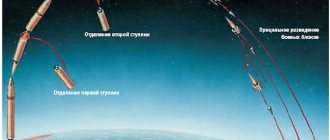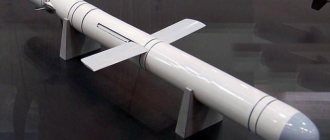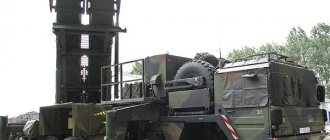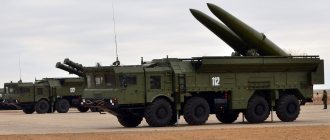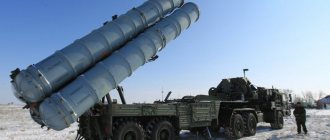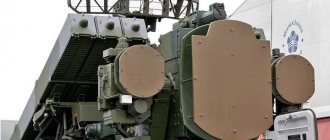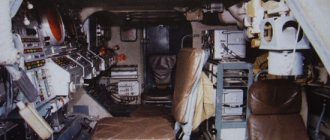ICBM type
| UR-100N SS-19 Stiletto | |
| Type | ICBM |
| Service history | |
| In service | 1975–present |
| Used | Russian Strategic Missile Forces |
| Production history | |
| Designer | NPO Mashinostroeniya |
| Manufacturer | Machine-building plant named after. Khrunicheva |
| Characteristics | |
| Weight | 105.6 tons |
| Length | 27 meters |
| Diameter | 2.5 m |
| Warhead | SS-19 Mod 3: up to 6 MIRV [1] SS-19 Mod 4: 1 Avangard HGV [1] |
| Explosion power | 400 thousand tons (mod. 3), [2] 5 million tons (mod. 2) |
| Engine | two stage liquid fuel
|
| Operating range | 10,000 km |
| Guidance system | inertial |
UR-100N
, also known as
the RS-18A
, is an intercontinental ballistic missile in service with the Soviet and Russian Strategic Missile Forces.
The missile received the NATO reporting designation SS-19 Stiletto
and the production designation
15A30
.
History of operations[edit]
The UR-100N reached initial combat readiness in 1974, and by 1978 the inventory amounted to 190 launchers. In 1979, the UR-100UTTH entered service and by 1983 had replaced many older missiles and reached a maximum number of 360 launchers. By 1991, their number had dropped to 300, and with the collapse of the Soviet Union, many Ukrainians became property of the country. 170 remained in Russia, although treaty obligations required the missiles to be rearmed with single warheads. As of 2022, the Strategic Missile Forces had 20 (and most likely 10) SS-19s in service. [8] Recent political events have led to the rearmament of missiles with Avangard hypersonic glide vehicles. (HGVs), with the HGV version of the missile designated SS-19 Mod 4
.
[9] [1] On December 27, 2022, the first missile regiment armed with the HGV Avangard
officially entered combat duty. [10]
The units that previously belonged to Ukraine were returned to Russia or decommissioned.
The Air Force National Aerospace Intelligence Center estimates that there were approximately 50 Mod 3 launchers operational as of June 2022.[11]
Strategic missile system UR-100N UTTH with 15A35 missile
The third generation intercontinental ballistic liquid missile 15A30 (UR-100N) with a multiple independently targetable reentry vehicle (MIRV) was developed at the Central Design Bureau of Mechanical Engineering under the leadership of V.N. Chelomeya. In August 1969, a meeting of the USSR Defense Council was held under the chairmanship of L.I. Brezhnev, at which the prospects for the development of the Strategic Missile Forces of the USSR were discussed and the proposals of the Yuzhnoye Design Bureau regarding the modernization of the R-36M and UR-100 missile systems already in service were approved. At the same time, the scheme for modernizing the UR-100 complex proposed by TsKBM was not rejected, but in essence - the creation of a new missile system UR-100N. On August 19, 1970, Government Decree No. 682-218 was issued on the development of the UR-100N (15A30) missile system with “the heaviest missile among light ICBMs” (this term was later adopted in the agreed treaties). Along with the UR-100N complex, a complex with the MR-UR-100 ICBM was created on a competitive basis (under the leadership of M.K. Yangel). The UR-100N and MR-UR-100 complexes were proposed to replace the UR-100 (8K84) family of light-class ICBMs, adopted by the Strategic Missile Forces in 1967 and deployed in large quantities (the peak of deployment was reached in 1974, when the number of simultaneously deployed ICBMs of this type reached 1030 units). The final choice between the UR-100N and MR-UR-100 ICBMs had to be made after comparative flight tests. This decision marked the beginning of what is called the “debate of the century” in historical and memoir literature on Soviet rocket and space technology. In terms of its performance characteristics, the UR-100N complex, with a missile that was very advanced in its main technical characteristics, was between the “light” MR-UR-100 and the “heavy” R-36M, which, according to a number of participants and observers of the “dispute of the century,” gave rise to V.N. Chelomeya hopes not only that his missile will be able to win the competition with the MR-UR-100, but also that, as it is cheaper and more widespread, it will be preferred to the relatively expensive heavy R-36M. Such views, of course, were not shared by M.K. Yangel. In addition, the country's leadership also considered it absolutely necessary for the defense of the USSR to have heavy class ICBMs in the Strategic Missile Forces, so the hopes of V.N. Chelomey’s plan to “replace” the R-36M with the help of the UR-100N did not materialize.
For V.N. Chelomey, the difficulty of creating a new missile also lay in the fact that the modification of the silo launcher of the UR-100 complex for the UR-100N missile with its “hot” “gas-dynamic launch” practically resulted in the complete dismantling of the existing silo launcher and the construction of a new one with the implementation of a full cycle of construction work ( To strengthen the shaft structure, it was necessary to completely dismantle the shaft, its head and a powerful foundation, carry out excavation work to increase the diameter of the shaft and construct a new reinforced concrete silo structure), because otherwise, there would be a real danger of the appearance in some places of the silo gas duct of a supersonic gas flow and shock waves with a sharp change in its regimes (pressure, temperature, heat transfer), leading to an emergency launch of a new promising rocket. Roughly speaking, only the center line remained unchanged from the previous silo, while the one proposed by M.K. Yangel’s new and risky concept of a “cold” “mortar launch” for both missiles developed by his team made it possible to actually get by with already built silos with the necessary modifications (this looked like a more efficient use of already built silos, i.e., as a more economical approach). When designing the silo structure of the new UR-100N missile system, testing the gas dynamics of the launch was entrusted to TsNIIMash. The Institute met this challenge with a small-scale model. Experiments were carried out on it with precision accuracy and small-sized gas exhaust devices were tested. To reduce unacceptably high levels of shock wave pressure on the UR-100N missile when starting its engine, a specially designed duralumin screen was installed in the lower part of the container, on the recommendation of the institute. When the rocket rose, the screen was destroyed under the influence of the jets, which subsequently ensured the ejection flow regime. At the same time, despite the large amount of work required, according to US intelligence services, silo OS 15P730 (then 15P730P, 15P735) held first place in terms of resistance to PFYV among other Soviet silo-based combat missile systems until the adoption of the R-36M2 Voevoda ICBM "(15A18M, silo OS 15P718M) and RT-23UTTH "Molodets" (15Zh60, silo OS 15P760). At the same time, the last complex became the leader. American experts in the 1980s assessed the probability of destroying the OS complex 15A35 silo launcher by two hits from a Mk12A warhead with a W78 warhead (Minuteman-III ICBM) each with a yield of 335 kt as 0.509, while two Mk12 warheads with a W62 warhead (Minuteman-III ICBM) with a capacity of 0.509 170 kt each destroyed the same silo with a probability of 0.333, and two Mk4 warheads with a W76 warhead (Trident I C4 SLBM) with a power of 100 kt each could not destroy this silo at all (probability 0). For the silo OS of the 15A18 complex, estimates by American analysts gave the following probability figures: 0.590 (Mk12A), 0.407 (Mk12) and 0.044 (Mk4).
Flight design tests of the 15A30 ICBM were carried out at the Baikonur training ground (chairman of the state commission - Lieutenant General E.B. Volkov). The first launch of the 15A30 ICBM took place on April 9, 1973. The tests were carried out according to an abbreviated program, since the developers presented calculations that justified this approach. This allowed testing to be completed in October 1975, when the last of 27 launches was completed. During the tests, launches were carried out with a monoblock warhead, as well as an MIRV with 4 and 6 warheads. The first regiment with BRK 15P030 went on combat duty in the 46th Lower Dnieper Red Banner Order of the October Revolution missile division (Pervomaisk, Nikolaev region, Ukrainian SSR) on April 26, 1975. On December 30, 1975, by Government Decree No. 1063-356, the UR-100N (15A30) missile system was put into service. The first regiment with UR-100N missiles, equipped with DBK 15P030P with increased resistance to PFYAV, went on combat duty in the 60th Taman Red Banner Order of the October Revolution missile division named after the 60th anniversary of the USSR (Tatishchevo, Saratov region, RSFSR) December 18, 1976 of the year. Later, all existing DBKs were brought to the level of 15P030P. For the creation of a reinforced silo launcher for the UR-100N missile system, the Lenin Prize was received by a group of military and civilian specialists, including Minister of Defense A.A. Grechko. The “debate of the century” itself ended quite unexpectedly - both the UR-100N and MR-UR-100 were adopted for service, although the latter in quantities much smaller than the former (finally - 360 versus 150). Work on the UR-100N complex as a whole turned out to be more complex and expensive (compared to the MR-UR-100 BRK), but it fully met the prospects for the development of missile weapons. In addition, apparently, the country's leadership was afraid of the possibility of concentrating the development of liquid-propellant ICBMs of all classes in “one hands” (Yuzhnoye Design Bureau).
Serial production of the 15A30/15A35 ICBM was launched in 1974 at the Moscow Machine-Building Plant named after M.V. Khrunicheva. The production of first-stage propulsion engines was mastered by the Voronezh Mechanical Plant and a branch of the Perm Engine-Building Plant named after Ya.M. Sverdlov. Second stage propulsion engines and steering engines were produced by the Leningrad Machine-Building Production Association "Red October". The engines of the breeding unit were manufactured by the Ust-Katavsky Carriage Plant. The control system components were assembled at the Kiev Radio Plant, the Taras Shevchenko Plant and the Kharkov NPO Khartron. The warhead breeding unit and the control system were produced at the Orenburg production association "Strela".
However, the “innovative” decision of the developers regarding the shortened test program also had negative consequences. During missile launches under the combat training program with firing at the maximum range in the second half of the 70s, a serious incident arose with the UR-100N missile system. When the UR-100N missile, which was on combat duty, was launched at maximum range in order to check the condition of the complexes, the results were unexpected. The deviations of the points of impact of the warheads from the aiming points far exceeded the calculated ones. The launch was repeated, the results were the same. It became clear that some kind of flaw was hidden in the design of the rocket, which was not revealed during testing. But dozens of missiles were already on combat duty, and preparations were being made for the delivery of new ones at an accelerated pace. The study of the reasons for unacceptable deviations of the falling points of the blocks made it possible to establish the following. In the last seconds of operation of the 1st stage rocket engine, intense longitudinal vibrations of the rocket began, causing resonant vibrations of the elements of the range control system. As a result of these fluctuations, the on-board instruments that measured the flight range gave an erroneous command to turn off the engines, which led to unacceptable deviations in the points where the blocks fell. The most experienced missile organizations - design bureaus, research institutes, test sites, etc. - were involved in the development of measures to eliminate vibrations of the UR-100N missile. Additional missiles were allocated for flight testing by a special decision. The lead organization was determined to be the Central Design Bureau of Mechanical Engineering, and the flight tests were entrusted to the same State Commission that conducted the tests of the UR-100N ICBM. The period of refinement of these missiles has begun. The work was organized as follows. Council of Chief Designers at the Central Design Bureau of Mechanical Engineering, chaired by V.N. Chelomeya developed proposals for improving the rocket. Corresponding changes were made at the missile manufacturing plant named after. M.V. Khrunicheva. The modified rocket was sent to the Baikonur test site, where it was launched according to a program that provided for complete burnout of the first stage fuel. Data obtained during launches made it possible to evaluate the effectiveness of the modification. Thus, several missile launches were carried out with various modification options. The results were negative - it was not possible to eliminate the fluctuations. Meanwhile, the deadlines and stocks of missiles released for modification were expiring. The situation was becoming threatening. A solution to the problem was found in a completely different place than where it was sought. General designer V.N. Chelomey insisted on altering the control system equipment to avoid resonant modes and replacing it on all missiles. However, NIITP researcher M.S. Natanzon proposed a simpler solution: install anti-vibrators (dynamic vibration dampers) in the tail section of the 1st stage of the rocket, tuned to a dangerous frequency and suppressing it in the vibration spectrum of the rocket. The manufacture and installation of such antivibrators were quite simple and cheap operations. TsNIIMash under the leadership of Yu.A. Mozzhorina conducted an extensive range of theoretical and experimental studies. Dynamic bench tests of a full-scale rocket with installed vibration dampers played a role in solving this problem. In a short time, the necessary calculations were carried out, vibration dampers were manufactured and installed on the rocket, which was being prepared for shipment to Baikonur. The results became known as soon as the first stage engines finished working - flight data was transmitted to the ground by a telemetry system. There were no unacceptable fluctuations. The launches of rockets with vibration dampers were urgently repeated. The results were the same. However, in the silos there were missiles on alert duty without vibration dampers. In extremely difficult conditions - at a depth of approximately 20 m - the dampers were installed. Subsequently, control missile launches were carried out dozens of times. The high reliability of the complexes has been confirmed. However, additional efforts and considerable financial resources had to be spent to eliminate the shortcomings.
On August 16, 1976, government decree No. 654-214 was issued on improving the tactical and technical characteristics (UTTC) of the UR-100N missile system. The modernization of the missile system was carried out in the following main directions: increasing resistance to nuclear weapons and increasing the combat effectiveness of the complex. The new missile differed from its predecessor in a new deployment stage (more resistant to PFJV, which made it possible to increase the firing range, improve the formation of formations from elements of combat equipment, increase the area of the BB deployment area), an improved control system (more resistant to PFJV, ensuring increased firing accuracy), which made it possible to select one of 6 targets pre-set for the missile in the control system, which significantly expanded the use of DBK), improved KSP missile defense, new warheads (more high-speed, powerful, accurate and resistant to PFYAV), increased resistance to PFYV for silo OS 15P735 and DBK 15P035 in general (later all existing DBK 15P030P were brought to the level of 15P035 with the ability to withstand pressure in a shock wave of up to 100 atmospheres). In general, the operation of missile systems has been significantly simplified, while resistance to the damaging factors of a nuclear explosion has been increased. All this was achieved without changing the size of the ICBM mass and the thrown mass. On October 26, 1977, flight design tests of the 15A35 rocket with improved performance characteristics (UR-100N UTTX) began at Baikonur. This time they were carried out in full. A total of 68 test launches of the improved missile were carried out from September 28, 1977 to July 26, 1979. All launches during the flight test were carried out: in the Kura region, in the Aquatoria region (at maximum range), in the Kzyl region -Tu" (for a minimum range of about 1000 km). On December 17, 1980, by Government Decree No. 1180-402, the UR-100N UTTH missile system was adopted for service. The first regiment with the new DBK was the regiment in the 19th Zaporozhye Red Banner Order of Suvorov and Kutuzov missile division (Khmelnitsky, Khmelnitsky region, Ukrainian SSR), which became fully operational in January 1981. By 1984, a total of 360 UR-100N UTTH missiles were deployed in only 4 position areas of the country (except for the 3 above - also the 28th Guards Red Banner Missile Division, Kozelsk, Kaluga region, RSFSR). Production of the missiles ceased in 1985. After the introduction of improved missiles into service in order to make fullest use of the capabilities of the complex with the 15A35 ICBM at the end of the first - beginning of the second half of the 80s, mobile reserve command posts (PKP) “Vybor” were formed in all operating units to increase the stability of the combat control system MAZ all-terrain chassis. To ensure the efficiency of calculating flight missions, computer centers were formed in the divisions.
The 15A30 ICBMs were initially placed in high-security silos developed by Branch No. 2 of the Central Design Bureau for Mechanical Engineering (now the State Scientific Research Institute of Design Bureau Vympel), headed by V.M. Baryshev. Later, all existing high-security mines were converted into high-security mines. A total of 360 high-security silo launchers (VZ silo launchers) were built. They were located in the positional areas of divisions stationed near the cities of Pervomaisk (90 OS silos), Khmelnitsky (90 OS silos), Tatishchevo (110 OS silos) and Kozelsk (70 OS silos). A total of 360 ICBMs of this type were deployed. Beginning in 1988, in formations stationed near the cities of Pervomaisk and Tatishchevo, the deployment of the 15Zh60 solid-fuel ICBM began instead of the 15A35 ICBMs, which were being removed from duty. By the end of 1989, 56 new missiles were put on combat duty, and in return 60 15A35s were removed from duty. However, starting in 1990, this process stopped until the collapse of the USSR at the end of 1991. After the collapse of the USSR, part of the still deployed 15A35 missiles (130 units) ended up on the territory of Ukraine and were subsequently eliminated in accordance with the letter of international treaties. However, 31 sets of 15S300 were not destroyed (ICBM 15A35 in TPK without warheads and control systems). Russia bought from Ukraine in 2002-2004. 30 such sets were stored in warehouses in an unfilled state. According to the then commander-in-chief of the Strategic Missile Forces of the Russian Federation N. Solovtsov, these missiles could remain on combat duty at least until 2022, and at most until 2030.
According to official data, as of July 2009, the Strategic Missile Forces of the Russian Federation had 70 deployed 15A35 ICBMs: 1. 60th Missile Division (Tatishchevo), 41 UR-100N UTTH 2. 28th Guards Missile Division (Kozelsk), 29 UR-100N UTTH.
The last division was previously in the process of liquidation, but by decision of the President of the Russian Federation D.A. Medvedev, the liquidation process was terminated in November 2008. The division will continue to be on duty with the 15A35 ICBM until it is re-equipped with “new missile systems” (apparently either Topol-M or RS-24). Apparently, in the near future, the number of 15A35 missiles on combat duty will be further reduced until it stabilizes at a level of about 20-30 units, taking into account purchased missiles. To compare with the data from July 2009 (when the figure was 70 ICBMs), as of January of the same year, 97 missiles of this type were deployed, and in January 2008, 110 units.
The UR-100N UTTH missile system is extremely reliable - 165 test and combat training launches were carried out, of which only three were unsuccessful. The American magazine of the Air Force Rocketry Association called the UR-100N UTTH missile “one of the most outstanding technical developments of the Cold War.” The first complex, still equipped with UR-100N missiles, was put on combat duty in 1975 with a warranty period of 10 years. During its creation, all the best design solutions worked out on previous generations of “hundreds” (8K84/UR-100, 8K84M/UR-100M, 15A20/UR-100K, 15A20U/UR-100U) were implemented. The high reliability indicators of the missile and the complex as a whole, then achieved during the operation of the improved complex with the UR-100N UTTH ICBM, allowed the military-political leadership of the country to set the Ministry of Defense, the General Staff, the command of the Strategic Missile Forces and the lead developer, NPO Mashinostroeniya, with the task of gradually extending the deadlines operation of the complex from 10 to 15, then to 20, 25 and finally to 30 years and beyond. In the 1990s, after the collapse of the USSR, the military-political leadership of the country decided to begin work on significantly extending the service life of the Republic of Kazakhstan with the UR-100N UTTH ICBM instead of permanently removing it from service and replacing it with a complex with the RT-23 UTTH “Well done” ICBM ", as originally planned in the second half of the 1980s. This task, given the acute shortage of budget funds allocated for the maintenance of existing and the purchase of new types of strategic and other weapons, was identified by the military-political leadership of the country as a particularly priority. Under these conditions, the role of long-term interaction between NPO Mashinostroeniya and the Strategic Missile Forces has significantly increased. Since 1996, NPO Mashinostroyenia, as the parent enterprise in joint cooperation with other enterprises, has been solving the most important task - carrying out work to extend the service life of the missile system with the UR-100N UTTH ICBM in conditions of combat duty (the “Zaryadye” topic). In order to carry out these works, on the initiative of NPO Mashinostroyenia, in 2000, the Council of General (Chief) Designers was created, whose task is to coordinate the work of the entire cooperation of enterprises - developers (manufacturers) of the components of the complex and services of the Strategic Missile Forces. Once every two years, the Council conducts its work directly at operating sites. Based on the results of the Council’s work, an appropriate decision is drawn up that determines the procedure for ensuring and extending the service life of the Republic of Kazakhstan with the UR-100N UTTH ICBM. The main result of work on this topic is confirmation of the high reliability of missile systems with the UR-100N UTTH ICBM that have been on combat duty for a long time. The task of ensuring such a long-term operation of the complex while maintaining high combat and technical characteristics was solved for the first time in the world. It was necessary to implement a lot of scientific research and development work, combined into one comprehensive program. Approaches have been found to predicting the state of the complex at least 2-3 years in advance. The safety margins of power structures are determined, the condition of the walls of fuel tanks is carefully checked, the condition of rocket fuel components is analyzed, accelerated tests are carried out in climatic chambers that ensure equivalent effects of environmental parameters on the design of components and assemblies of the rocket complex. The experience gained is universal and is used to extend the service life of all systems with liquid rockets.
An important step in confirming the main performance characteristics of the rocket is the regularly conducted launches of the UR-100N UTTX from the Baikonur cosmodrome. The rocket with the maximum service life is selected for launch. The latest launch to date was carried out on October 22, 2008, when the UR-100N UTTH rocket was launched from Baikonur. The warhead successfully hit targets at the Kura training ground. The launch confirmed the invariability of the main flight performance characteristics of the RS-18B ICBM, and also showed a high degree of reliability of the system for operating combat missile systems. In December 2008, based on the results of tests and research, a decision was made to extend the service life of the missiles to 33 years. Economic calculations show that the preservation of UR-100N UTTH missiles as part of the strategic nuclear forces of the Russian Federation over the last 10 years alone has made it possible to free up several tens of billions of rubles for solving important government tasks. It was noted that during operation, UR-100N UTTH missiles were launched not only at the maximum (10,000 km), but also at the minimum (about 1,000 km) range, which ensures the flexibility of its use in modern changing geopolitical conditions. A significant amount of experimental data to extend the service life of the RS-18B ICBM is also being acquired as part of the program for the use of Rokot conversion launch vehicles, for which the 15S300 unit (1st and 2nd sustainer stages of the 15A35 ICBM in the standard TPK 15Ya64) is supplied from the Strategic Missile Forces to the Space Forces after carrying out appropriate verification activities. Based on the results of research carried out in February 2011, it was announced the possibility of increasing the guaranteed service life of the 15A35 ICBM to 36 years.
Over the past decade, information of various kinds has repeatedly appeared in the media, containing information about the need and even the beginning of work on the creation in the Russian Federation, through domestic cooperation of manufacturers, of a new liquid-fueled ICBM weighing about 100 tons with MIRVs in order to put it into service in the “after” period. 2015,” however, no specific indications of the start of work in this direction were officially announced for a long time. Both supporters and opponents of this idea noted that, most likely, the final decision in this area will be made based on the final results of MIT's work on promising weapons - ICBMs with MIRV RS-24 and SLBMs with MIRV R-30 "Bulava" ", these results should finally manifest themselves in the next year or two (the presence of the RS-24 ICBM in the troops and the performance of experimental combat duty at this complex was announced in July 2010, and already in March 2011 it was announced that this complex for combat duty). If this work is completed successfully and the latest mobile solid-fuel ICBMs and SLBMs with MIRVs enter service with the Strategic Missile Forces and the Russian Navy in sufficient quantities, then the need to create a promising liquid-propellant ICBM will probably disappear. In addition, opponents of the creation of a new liquid-fueled ICBM, the main advantage of which is the ability to deploy a significant number of high-power warheads on one missile, point out that in modern conditions (the validity of the START-3 treaty, the presence of high-precision weapons in a number of countries, etc.) its main advantage, along with being based in the OS silo, will also become its main disadvantage - a large number of warheads can be disabled by striking a relatively small number of stationary carriers in the OS silo. At the same time, in February 2011, it was announced about the possibility of creating a promising heavy ICBM with a significant number of warheads on board as a replacement for the R-36M2 Voevoda ICBM and UR-100N UTTH with entry into service by 2022. In April 2011, on the creation of a missile that will have significantly increased combat survivability due to design excellence, enhanced fortification protection of the OS silos and the adoption of other passive and active protection measures (including air defense and missile defense systems of the basing area) with the maximum possible use already deployed infrastructure of predecessor missiles, it was officially announced by representatives of the Strategic Missile Forces. The adoption of the new missile into service is planned by the end of 2022; its creation will also involve enterprises of the “naval” cooperation that previously created liquid-fueled SLBMs, led by the State Research Center named after. V.P. Makeeva.
In the West, the 15A35 (UR-100N UTTH) missile received the designation SS-19 mod.3 Stiletto (under the SALT-1 RS-18B agreement), and the 15A30 (UR-100N) - SS-19 mod.1,2 Stiletto (under the agreement OSV-1 RS-18A).
START I Treaty[edit]
The START I Treaty was signed by the Soviet Union in 1991. The treaty required the Soviet Union to begin the process of dismantling nuclear warheads and launchers used for SS-19 missiles. [12] The Soviet Union had 300 100NUTTH missiles deployed in both Russia and Ukraine: 130 in Ukraine and the rest throughout Russia. [13] After the collapse of the USSR, Ukraine claimed ownership of all missiles stationed on its territory. Ukraine then began dismantling the SS-19 missile launchers in accordance with the START I treaty. Nuclear warheads that were stationed in Ukraine were also dismantled in accordance with the terms of the treaty. [14]
Links[edit]
- ^ abc Christensen, Hans M.; Korda, Matt (March 4, 2022). "Russian Nuclear Forces, 2019". Bulletin of the Atomic Scientists
.
75
(2): 73–84. DOI: 10.1080/00963402.2019.1580891. - "SAGE Journals: Your Path to World-Class Journal Research". bos.sagepub.com
. - ^ a b “RD-0233, RD-0234, RD-0235, RD-0236, RD-0237. Intercontinental ballistic missiles RS-18". KBHA. Retrieved June 19, 2015.
- ^ ab Zach, Anatoly. "UR-100N Family". RussianSpaceWeb.com
. Retrieved June 19, 2015. - "RD-0237". Encyclopedia Astronautica
. Archived from the original on August 24, 2015. Retrieved June 19, 2015. - "Krivonosov, Khartron: Computer for missile guidance systems". web.mit.edu
. - "Archival copy". Archived from the original on March 31, 2013. Retrieved 14 September 2015.CS1 maint: archived copy as title (link)
- Christensen, Hans M.; Norris, Robert S. (April 30, 2022). "Russian Nuclear Forces, 2018". Bulletin of the Atomic Scientists
.
74
(3): 185–195. Bibcode: 2018BuAtS..74c.185K. DOI: 10.1080/00963402.2018.1462912. - Xavier. “Russia has begun serial production of the Avangard hypersonic missile - March 2022. News of the world defense industry - News of the world defense industry army 2022 - News archive of the year". armyrecognition.com
. - The “First Rocket Regiment” of the Avangard “has taken up combat duty.” TASS
. December 27, 2022. Retrieved December 27, 2022. - https://www.nasic.af.mil/LinkClick.aspx?fileticket=F2VLcKSmCTE%3d&portalid=19
- Goodbye James (1998). United Europe: a new logic of peace in US-Russian relations
. Washington, DC: US World Press Institute. paragraph 81. - Pike, John. "UR-100N/SS-19 STILLETO". www.globalsecurity.org
. Retrieved April 27, 2022. - Podvig, Pavel (2004). Russia's Strategic Nuclear Forces
. Massachusetts Institute of Technology. paragraph 223. - Christensen, Hans M.; Korda, Matt (9 March 2022). "Russian Nuclear Forces, 2020". Bulletin of the Atomic Scientists
.
76
(2): 73–84. DOI: 10.1080/00963402.2020.1728985.
Development
The UR-100N class intercontinental ballistic missile (ICBM) (START code - RS-18A) was developed in the design bureau of Vladimir Chelomey . Work began in 1967, after the USSR government adopted a decree on the development of a new missile system. On April 9, 1973, the first test launch took place at the Baikonur test site. Testing of the missile was completed in October 1975, and on December 30, 1975 it was put into service.
At the design bureau, work on the missile continued, and on October 26, 1977, the first launch of a missile with improved tactical and technical characteristics UR-100N UTTH (START code - RS-18B) took place. Flight tests of the rocket were carried out at the Baikonur Cosmodrome between 1977 and 1979, and on December 17, 1980 the rocket was put into service.
The missile system was deployed from 1979 to 1984; a total of 360 missiles were put on combat duty. In 1980–1982, all UR-100N monoblock missiles were replaced with UR-100N UTTH. The replacement of all UR‑100N complexes was completed in 1983.
Question answer
Containerized missile system Club-K. Infographics
